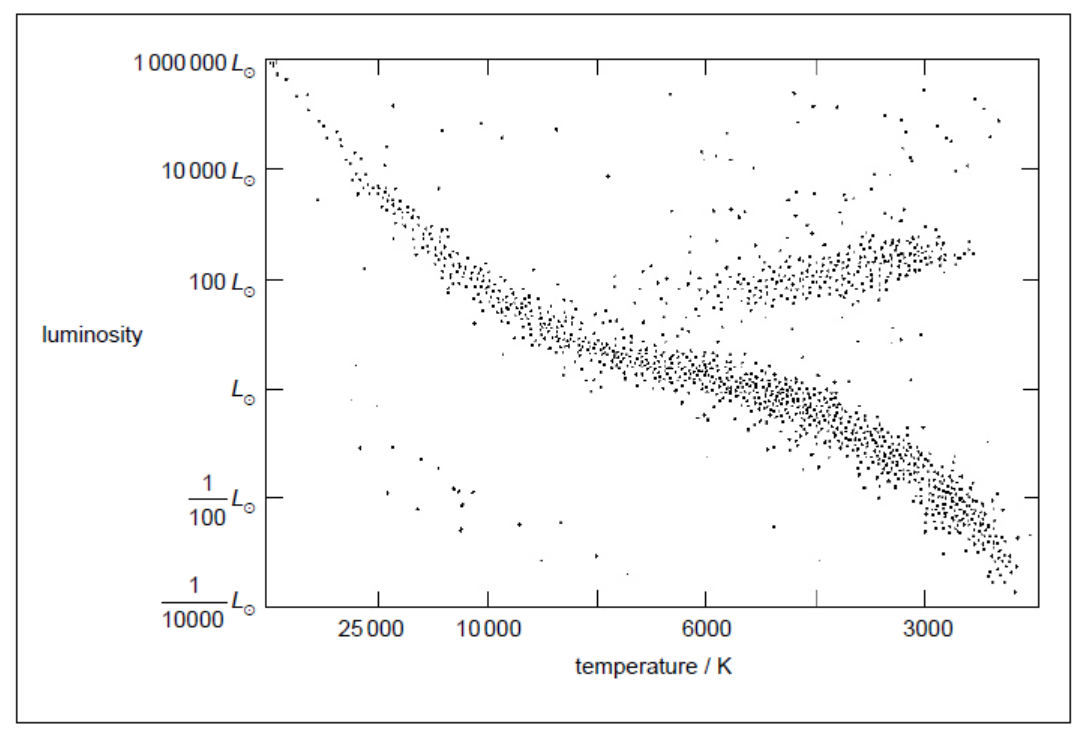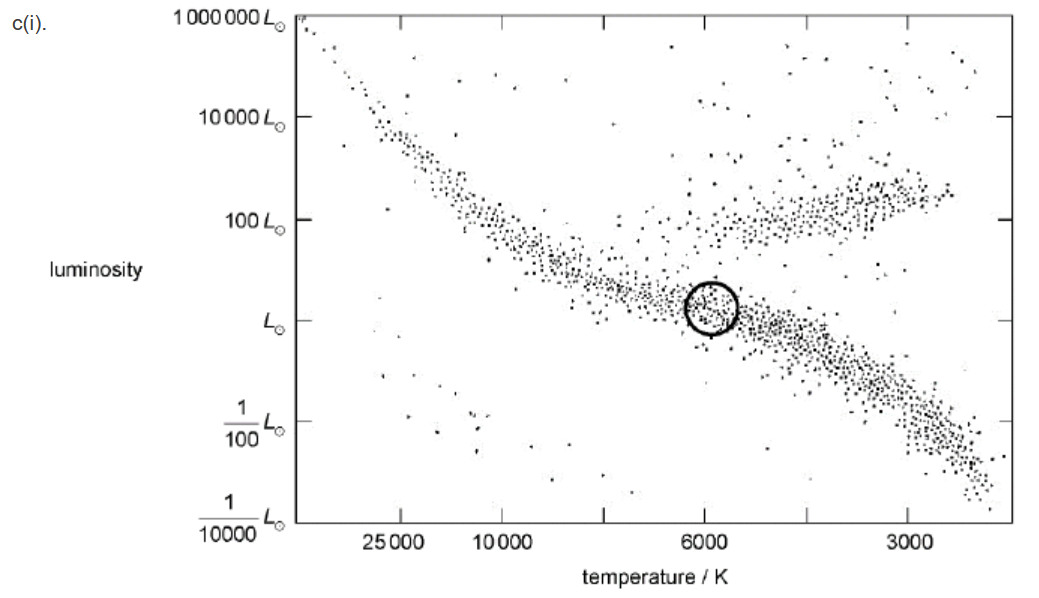Question
Eta Cassiopeiae A and B is a binary star system located in the constellation Cassiopeia.
The following data are available.
Apparent brightness of Eta Cassiopeiae A $=1.1 \times 10^{-9} \mathrm{Wm}^{-2}$
Apparent brightness of Eta Cassiopeiae $B=5.4 \times 10^{-11} \mathrm{Wm}^{-2}$
Luminosity of the Sun, $L_{\odot}$
$=3.8 \times 10^{26} \mathrm{~W}$
A Hertzsprung-Russell (HR) diagram is shown.

a. Distinguish between a constellation and a stellar cluster.[2]
b(i).The peak wavelength of radiation from Eta Cassiopeiae A is $490 \mathrm{~nm}$. Show that the surface temperature of Eta Cassiopeiae A is about $6000 \mathrm{~K}$.[2]
$\mathrm{b}$ (ii)The surface temperature of Eta Cassiopeiae B is $4100 \mathrm{~K}$. Determine the ratio $\frac{\text { radius of the Eta Cassiopeiae A }}{\text { radius of the Eta Cassiopeiae B }}$.
$\mathrm{b}$ (iii)he distance of the Eta Cassiopeiae system from the Earth is $1.8 \times 10^{17} \mathrm{~m}$. Calculate, in terms of $L_{\odot}$, the luminosity of Eta Cassiopeiae A.[2]
c(i).On the HR diagram, draw the present position of Eta Cassiopeiae A.[1]
c(ii)State the star type of Eta Cassiopeiae A.[1]
$\mathrm{c}$ (iii) Calculate the ratio $\frac{\text { mass of Eta Cassiopeiae A }}{\text { mass of the Sun }}$.[1]
c(ivDleduce the final evolutionary state of Eta Cassiopeiae A. [2]
▶️Answer/Explanation
Ans:
a. stars in a cluster are gravitationally bound $O R$ in constellation are not
stars in a cluster are the same/similar age $O R$ in constellation are not
stars in a cluster are close in space/the same distance away $O R$ in constellation are not
stars in a cluster originate from same gas cloud $O R$ in constellation do not
stars in a cluster appear much closer in night sky than in a constellation
Notes: Take care to reward only 1 comment from a given marking point for MP1 to MP5.
$
\begin{gathered}
\mathrm{b}(\mathrm{i}) \lll T=\frac{2.9 \times 10^{-3}}{490 \times 10^{-9}} » \\
5900 \mathrm{~K} \checkmark
\end{gathered}
$
NOTE: Answer $6000 \mathrm{~K}$ is given in the question.
Answer must be to at least 2 s.f. OR correct working.
$\mathrm{b}\left(\mathrm{iii}\right.$ s from $b \propto L \propto R^2 T^4$ »
realization that $R^2 \propto \frac{b}{T^4}$ «for binary stars which are same distance away» $\checkmark$
$
\frac{R_{\mathrm{A}}}{R_{\mathrm{B}}}=\sqrt{\frac{\left(\frac{1.1 \times 10^{-9}}{5.4 \times 10^{-11}}\right)}{\left(\frac{5900}{4100}\right)^4}}
$
$
\frac{R_{\mathrm{A}}}{R_{\mathrm{B}}}=2.2
$
NOTE: Award [2] for answer 0.46 from inverted ratio.
$\mathrm{b}$ (iiik)use of $L=4 \pi d^2 b »$
$
\begin{aligned}
& L=4 \pi \times\left(1.8 \times 10^{17}\right)^2 \times 1.1 \times 10^{-9} \ll=4.48 \times 10^{26} \mathrm{~W} \gg \checkmark \\
& L=1.2 L_{\odot} \checkmark
\end{aligned}
$

approximately correct position on the main sequence as shown, within highlighted region
c(ii)main sequence star
OR
type F or G star
$\mathrm{c}\left(\mathrm{iii} \frac{M}{M_{\odot}}=1.2 \frac{1}{3.5}=1.05\right.$
c(iv)hass of the «remnant» star $<1.4 M_{\odot}$ OR Chandrasekhar limit
OR
mass OR luminosity similar to the Sun
the final stage is white dwarf
Question
Eta Cassiopeiae A and B is a binary star system located in the constellation Cassiopeia.
Distinguish between a constellation and a stellar cluster.
▶️Answer/Explanation
Ans:
stars in a cluster are gravitationally bound $O R$ in constellation are not stars in a cluster are the same/similar age $O R$ in constellation are not stars in a cluster are close in space/the same distance away OR in constellation are not stars in a cluster originate from same gas cloud $O R$ in constellation do not stars in a cluster appear much closer in night sky than in a constellation
NOTE: Take care to reward only 1 comment from a given marking point for MP1 to MP5.